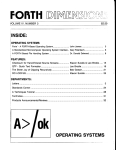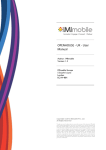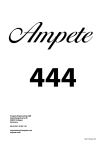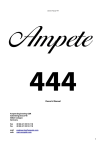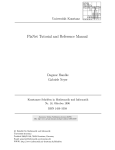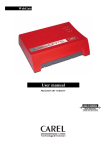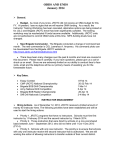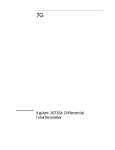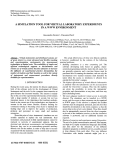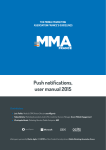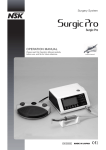Download to view the Adjudication decision
Transcript
Code Compliance Panel Tribunal Decision Tribunal meeting number 152 / Case 1 Case reference: Level 2 provider: Type of Service: Level 1 provider: Network operator: 29242 Clarium Telecom Limited (St Kitts and Nevis) Virtual chat service IMImobile Europe Limited (UK) and Netsize Internet Payment Exchange AB (UK) All Mobile Network operators THIS CASE WAS BROUGHT AGAINST THE LEVEL 2 PROVIDER UNDER PARAGRAPH 4.4. OF THE CODE BACKGROUND Between 25 June 2013 and 5 December 2013, PhonepayPlus received 18 complaints from consumers in relation to a virtual chat service, (the “Service”), which operated under the brand names “Instamatch” and “40 Second Match” (formerly known as “Speedmeet”). The Service was operated by the Level 2 provider Clarium Telecom Limited (the “Level 2 provider”) on the premium rate shortcodes 82233 and 84439. Consumers were charged £1.50 for each SMS message received (up to seven messages may have been received for each message sent). The Level 1 provider for shortcode 84439 was Netsize Internet Payment Exchange AB and the Level 1 provider for shortcode 82233 was IMImobile Europe Limited. The Service commenced operation on 7 February 2013. The Instamatch Service was voluntarily suspended on 19 October 2013 and the 40 Second Match Service (operating under the brand name “Speedmeet” until August 2013) was voluntarily suspended on 4 October 2013, following correspondence with PhonepayPlus. Consumers engaged with the Service after viewing and clicking on a promotional banner advertisement (“banner ad”), which directed them to a Service webpage. By entering a MSISDN into a field on the webpage, consumers would be sent a free SMS message inviting them to send their age to a Service shortcode to opt-in to the Service. For a short period of time, some consumers had been able to interact with the Service by responding to a promotional SMS message sent from a long number. The majority of complainants stated that they had not interacted with the Service but had incurred unsolicited charges. Other complainants reported receiving and responding to SMS messages but stated that they were unaware they would incur charges. The investigation The Executive conducted this matter as a Track 2 investigation in accordance with paragraph 4.4 of the PhonepayPlus Code of Practice (12th Edition) (the “Code”). The Executive sent a breach letter to the Level 2 provider on 20 May 2014. Within the breach letter the Executive raised the following breaches of the Code: Rule 2.3.2 – Misleading Rule 2.4.2 – Consent to market Paragraph 3.9.2 – Appropriate use of a number range 1 Code Compliance Panel Tribunal Decision The Level 2 provider responded on 6 June 2014. On 26 June 2014, the Tribunal reached a decision on the breaches raised by the Executive. The Tribunal considered the following evidence in full: - The complainants’ accounts; The complainants’ message logs; The Executive’s monitoring of the Service; Correspondence with the Level 2 provider (including requests and directions for information and the Level 2 provider’s responses); The Level 2 provider’s “Chat panel manual”; PhonepayPlus Guidance on “The appropriate use of number ranges”; PhonepayPlus Guidance on “Virtual chat services”; PhonepayPlus Guidance on “Privacy and consent to charge”; The breach letter of 20 May 2014; and The Level 2 provider’s response to the breach letter of 6 June 2014. SUBMISSIONS AND CONCLUSIONS ALLEGED BREACH 1 Rule 2.3.2 “Premium rate services must not mislead or be likely to mislead in any way.” 1. The Executive submitted that the Level 2 provider had acted in breach of rule 2.3.2 of the Code as, due to the following factors, consumers had been, or were likely to have been, misled into the belief that they were sending messages to other consumers of the Service and had the opportunity to meet them: the promotions for the Service; and the content of the operators’ messages. The Executive relied on the content of the PhonepayPlus Guidance on “Virtual chat services” and “Promotions and promotional material”. The Guidance states: Promotions and promotional material Paragraph 3.1 “If consumers are to have trust and confidence in using PRS, it is important that they have available all the key information about a service as part of their consideration of whether to make a purchase or not. For this reason, it is important that promotions do not mislead consumers by stating an untruth or half-truth. It is also important that promotions do not omit, or make insufficiently prominent, an important term or condition likely to affect their decision to use the service.” Paragraph 3.2 “PhonepayPlus expects that all promotions must be prepared with a due sense of responsibility to consumers, and promotions should not make any factual claims that cannot be supported with evidence, if later requested by PhonepayPlus to do so.” Virtual chat services 2 Code Compliance Panel Tribunal Decision Paragraph 3.1 “Promotions for virtual chat services should not lead consumers to believe that they will be exchanging messages with other consumers, or that they may be able to meet other consumers by using the service, unless that is the case.” Paragraph 3.2 “Use of words such as ‘meet’ and ‘date’ may be deemed misleading if the consumer does not, in fact, have the opportunity to meet any other users or operators of the service. Operators should not indicate to consumers that a meeting can take place, where this is not a function of the service. Where a consumer does request a meeting, expectations should be managed correctly and operators should inform the consumer that the purpose of the service is for ‘fantasy chat’ only.” The Executive noted that the Level 2 provider had confirmed that the Service was an operator based virtual chat service. Promotions for the Service Banner ads The Level 2 provider supplied the Executive with examples of banner ads that had been displayed on various websites to promote the Service (Appendix A). Upon selecting the banner ads consumers would be directed to a website for the Service (Appendix B). The Executive asserted that the following elements contained on the promotional banner ads were likely to mislead consumers: the “connect to the girl of your dreams” wording; the “click here to get connected to the girl of your dreams” wording; the Service was described as a “contact service” and there was no express wording to confirm that the Service was a virtual chat service; and the brand names for the Service were “InstaMatch”, “40 Second Match” and formerly “Speedmeet”. The Executive submitted that individually and cumulatively the effect of all these factors misled, or were likely to mislead consumers into believing that the Service provided them with an opportunity to message another users, rather than a paid operator, and that there would be an opportunity to meet each other. The 40 Second Match website On 22 November 2013, the Executive visited the 40 Second Match website and obtained screenshots (Appendix B, C and D). The Executive noted that the website stated, “Get a match in 40 seconds” and “Girls nearby”. Below the text were nine photographs of females and an icon that stated, “Click to be matched with a girl”. The Executive asserted that the wording and the photographs on the webpages were misleading as consumers were likely to believe that the Service was being used by genuine female consumers who were available to contact and potentially meet. 3 Code Compliance Panel Tribunal Decision In addition, the Executive noted by scrolling down the webpage that there was a purported “review” from a user of the Service which was displayed in a bold pink and stated (Appendix D): “I’ve been matched with a complete stunner! things are moving along pretty fast” Dean, 34 Tottenham Oct 2013” The Executive submitted that the statement was highly misleading as it was likely to give consumers the impression that the Service offered them an opportunity to be matched with another genuine consumer who may be interested in a relationship. The Executive noted that the statement was highlighted in a bright bold pink coloured text, which made it stand out from the smaller text containing the terms and conditions. Only upon reading the terms and conditions would a consumer be aware of the real nature of the Service. The Executive further noted the position of the terms and conditions below the fold on the 40 Second Match website which it submitted, meant that end users would be less likely to notice and read the information, but would instead be drawn to the images of “Girls nearby” and the bold pink review statement. The Executive visited the 40 Second Match website again on 7 February 2014, and noted that the review which had been viewed on 22 November 2013 was still present, but the date of the review had been changed to January 2014. The Executive asserted that not only did the review create the impression that a consumer could contact and meet another user of the Service, but the amended date was likely to mislead consumers into believing that the review had recently been created and therefore the Service had recently been used by a consumer who had met a potential match. Complainant message logs At the request of the Executive, the Level 2 provider supplied message logs for 17 of the complainants. The Executive noted that in two of the message logs the operator clearly gave the consumer the indication that there was a possibility of meeting one another. The Executive relied on the full message logs but particularly noted the following: “Complainant: …would you like to meet for a coffee some time or is that incredibly forward? Operator: well I thought we could enjoy getting to know one another like this for now [complainant’s name], would this be ok? Xx Complainant: Of course yes just thought because we were so close we could meet, but this is absolutely fine. Operator: … honey I’m sure we will in time I just cant today is that ok?” “Complainant: I relly cant wait see you babe xxxx Operator: Aww that’s nice honey I can’t wait to see u either really looking forward to it xx [sic]” “Complainant: Maybe we could meet tomorrow Operator: Babe. I can’t tomorrow, I’ve got work tomorrow. Oh my gosh, I’m so sorry! x Complainant: Is it a wind up or am I just spending more with this company what about tonight 4 Code Compliance Panel Tribunal Decision Operator: What do you mean by that..? x Complainant: I said how about tonight Operator: Babe, I can’t I already have plans for tonight. I thought we were going to get to know one another?... Complainant: …I need to meet u soon its costing us both a fortune I can’t understand why u want to waste money like this unless u work for them x Operator: You just have to understand the fact that I am female and sometimes we have to be extra careful hope you understand? x [sic]” “Complainant:Ye I relly cant wait meet you and get know you xxxx what about you x… Operator: You can’t? AW! Yay I’m glad you’re looking forward to it too Complainant: We are still meeting aret we xx Operator: Yup, we are, You asked me that earlier babe. Dont u like me anymore? :(“ The Executive asserted that the message logs clearly demonstrated that the complainant had been misled into believing that he was messaging another user of the Service (rather than a paid operator) and that there would be an opportunity to meet. Further, the message logs demonstrated that when the complainant questioned the operator about the nature of the Service, the operator did not clarify that they would not be able to meet as the Service only offered a virtual chat service. The Executive submitted that the dialogue in the message logs was contrary to paragraph 3.2. of the Guidance detailed above, which requires operators on virtual chat services to clarify to consumers that the Service is a virtual chat service in instances where consumers believe that a face-to-face meeting might be possible. The Executive noted that the Level 2 provider had submitted a copy of its “Chat Panel Manual” which contained rules governing its operator’s conduct. The manual stated: “Under no circumstances can you ever talk about the possibility of meeting with any of the clients. If any operator is caught discussing meetings with users will be disciplined and could potentially be dismissed. If a user asks about the possibility of meeting, you must inform them you can only chat via SMS, and there is no possibility of a meeting taking place [sic]” Despite these rules, the Executive asserted that it was clear that there were instances where operators had acted against them. In light of the promotions and the conduct of the operators, consumers had been or were likely to have been misled into believing that they were messaging real users of the Service (and not paid operators) and that there would be an opportunity to meet face-to-face. Accordingly, the Executive asserted that, for all the reasons outlined above, the Level 2 provider had acted in breach of rule 2.3.2 of the Code. 2. The Level 2 provider admitted that a breach of rule 2.3.2 of the Code had occurred and stated that, although it was not its intention, it acknowledged that some consumers may have been misled. During correspondence, the Level 2 provider stated that any operator who had alluded to meeting a consumer had not acted in accordance with its rules and this type of conduct was not tolerated. It stated that operators who have behaved in this way were reprimanded. The Level 2 provider explained that it had spent a significant period of time and effort in an attempt to identify this type of behavior and prevent reoccurrence. The procedures it had in 5 Code Compliance Panel Tribunal Decision place included encouraging operators and moderators to report non-compliant message content and continuing use of non-compliant messages would result in operators being given a warning. Two warnings would result in the instant dismissal of an operator. The Level 2 provider stated that the “fantasy” element of the Service attracted some consumers. Therefore, it asserted that it would be unrealistic to expect operators to remind every consumer that the person they were messaging was a paid operator. It stated that the vast majority of consumers understood that it was a fantasy chat service and they used it in the correct way. Despite this, it accepted that in some isolated cases, operators had gone too far. 3. The Tribunal considered all the evidence before it, including the written submissions from the Level 2 provider. The Tribunal noted that the Level 2 provider had admitted that some consumers may have been misled regarding the nature of the Service. The Tribunal noted the content of the banner ads and the 40 Second Match webpage promotions and found that there were a number of elements that were likely to mislead consumers into believing that they were able to message other users of the Service, rather than paid operators, and have an opportunity to meet other users. The Tribunal commented that elements such as the brand names, photographs of “users”, reviews of the Service and phrases such as, “To connect to the girl of your dreams”, and “Girls nearby” (which was placed near photographs of “users”) were highly likely to mislead consumers. The Tribunal found that while the individual factors had or were likely to mislead consumers, taking all these factors together, the misleading effect on consumers was likely to have been much more significant. In addition, the Tribunal noted that two out of the 17 complainant message logs demonstrated that some operators had given consumers a clear indication that there would be an opportunity to meet. The Tribunal commented that the responses in some complainant message logs made it clear that consumers had been misled by the operator into believing that they were messaging another user of the Service and that there would be an opportunity to meet one another. Consequently, in light of the Level 2 provider’s admission and for all the reasons given by the Executive, the Tribunal concluded that consumers had or were likely to have been misled about the nature and operation of the Service. Accordingly, the Tribunal upheld a breach of rule 2.3.2 of the Code. Decision: UPHELD ALLEGED BREACH 2 Rule 2.4.2 “Consumers must not be contacted without their consent and wherever a consumer is contacted the consumer must be provided with an opportunity to withdraw consent. If consent is withdrawn the consumer must not be contacted thereafter. Where contact with consumers is made as a result of information collected from a premium rate service, the Level 2 provider must be able to provide evidence which establishes that consent.” 1. The Executive asserted that the Level 2 provider had acted in breach of rule 2.4.2 of the Code as complainants had reported receiving unsolicited SMS messages and the Level 2 6 Code Compliance Panel Tribunal Decision provider had been unable to provide sufficient robust evidence to establish that the complainants had consented to be contacted. The Executive relied on the content of PhonepayPlus Guidance on “Privacy and consent to charge”. The Guidance states: Paragraph 2.5 “Some services are initiated by a consumer entering a mobile number on a website, or a mobile website (i.e. a website browsed on the mobile handset). In recent years, consumers have not appreciated that doing so can result in a charge being generated to their mobile device, or that the entry of their number can be taken as being consent to future marketing by the provider concerned. Paragraph 2.6 “As a result, some consumers have entered a mobile number belonging to someone else (either by mistake or deliberately) and this has generated a charge to a second – unwitting – consumer. Even if there are no chargeable messages, just free marketing messages, the unwitting consumer often feels that their privacy has been invaded (see Part Two for further information around marketing). Paragraph 2.7 “For this reason, we recommend that consumers should always be encouraged to initiate services, or future marketing, with an MO. Failing that: All costs should be clearly stated and be proximate and prominent to the field where the consumer is to enter their number; After entering the number, a Mobile Terminating message (‘MT’) should be sent to the consumer. As an example this should state: “FreeMsg: Your PIN is [e.g. 0911], please delete if received in error” Paragraph 2.8 “An MT message, in these circumstances, should not promote the service itself (e.g. use its name), or give the consumer the option to reply YES to initiate the service. In addition, this method would require robust systems for verifying any PIN once entered (see paragraph 2.12 below for further details). Paragraph 2.9 “It is more difficult to verify where a charge is generated by a consumer browsing the mobile web, or by using software downloaded to their device. In these circumstances, where the consumer may only have to click on an icon to accept a charge, the MNO has no record of an agreement to purchase, and so robust verification is not possible through an MNO record alone. Paragraph 2.10 “In both of the instances set out above, we would expect providers to be able to robustly verify consent to charge (or to marketing, see Part Two of this General Guidance Note). Factors which can contribute to robustness are: An opt-in is PIN-protected (e.g. the consumer must enter their number to receive a unique PIN to their phone, which is then re-entered into a website); A record is taken of the opt-in, and data is time-stamped in an appropriately secure web format (e.g. https or VPN); 7 Code Compliance Panel Tribunal Decision Records are taken and maintained by a third-party company which does not derive income from any PRS. We may consider representations that allow a third-party company which receives no direct share of PRS revenue from the transaction, but does make revenue from other PRS, to take and maintain records. It will have to be proven to PhonepayPlus’ satisfaction that these records cannot be created without consumer involvement, or tampered with in any way, once created; PhonepayPlus is provided with raw opt-in data (i.e. access to records, not an Excel sheet of records which have been transcribed), and real-time access to this opt-in data upon request. This may take the form of giving PhonepayPlus passwordprotected access to a system of opt-in records; Any other evidence which demonstrates that the opt-in cannot be interfered with.” The Executive noted that the majority of the complainants had stated that they had received at least one message from the Service without consenting to being contacted. The Executive relied on all these complaints but particularly noted the following: “Usol msgs as consumer hasn’t signed up to any services”. “Consumer received an unsolicited message of adult nature”. “Consumer has been receiving unsol text messages from 82233”. “Receiving distasteful adult messages….Service not used or requested”. “Keep getting random text messages offering sex chats and it costs me over £1 every time it text me” The Executive noted from the message logs provided by the Level 2 provider that the first message received by the complainants appeared to be a free MT message from the Level 2 provider. During the investigation, the Level 2 provider had supplied “server logs” for three complainants, which it stated was evidence of , “site activity and IP addresses at the times [it] received the data”. The Executive was unable to determine exactly what evidence the server logs provided, as the information consisted of encrypted IP addresses and URLs in a single word document. Subsequently, the Executive requested that the Level 2 provider supply evidence to demonstrate how all the complainants had consented to be contacted and opt-in to the Service. In response, the Level 2 provider stated that the majority of complainants had initiated the Service by clicking on an online banner ad and entering a MSISDN when prompted. The Executive made a further request for the evidence to be provided and in particular, a time stamp for each complainant that had clicked on a banner ad and entered their MSISDN on a Service website to initiate the sending of a SMS message. The Level 2 provider responded on 14 March 2014 and stated: “..we only keep server logs for 6 months – as most of the logs date from July and August last year we no longer store this data.” 8 Code Compliance Panel Tribunal Decision The Level 2 provider was also requested to provide the “server logs”, (that had previously been supplied) in an unencrypted format. However, the Level 2 provider reiterated its response that it no longer held the data and was not able to provide the information. The Executive stated that it was not satisfied that the information provided was robustly verifiable evidence that demonstrated the complainants’ consent to be contacted. The Executive noted that the server logs were generated in-house by the Level 2 provider and presented in a word document that could have easily been interfered with. Accordingly, the Executive submitted that the Level 2 provider had failed to provide robust evidence that complainants had consented to be contacted and in light of the consistent complainant accounts, the Executive asserted that, on the balance of probabilities consumers had been contacted without their consent and the Level 2 provider had acted in breach of rule 2.4.2 of the Code. 2. The Level 2 provider admitted that evidence of the complainants’ consent to be contacted had not been recorded in a manner that could be robustly verified. During correspondence, the Level 2 provider stated that it had only kept server logs for six months. However, it had since ensured that its technical team kept logs for 12 months. Despite accepting that evidence of consent had not been kept for a sufficient period of time, it submitted that no consumers had ever been sent unsolicited reverse-billed SMS messages. 3. The Tribunal considered all the evidence before it, including the Level 2 provider’s written submissions and its admission that it had not recorded some consumers’ consent to be contacted in a robustly verifiable format. The Tribunal considered the content of the complainants’ accounts, which it found demonstrated that complainants consistently reported receiving an unsolicited SMS message from the Level 2 provider. Further, it observed that the complainants’ message logs showed that the first contact with them was a free MT message. The Tribunal noted one particular complainant that had reported receiving an SMS message from the Service. When the Level 2 provider was requested to provide details of the complainants’ interaction with the Service, it stated that it had “no record” of the complainant’s MSISDN. The Tribunal also noted that a number of requests had been sent to the Level 2 provider to provide robustly verifiable evidence of complainants consent to be contacted. While it acknowledged that the Level 2 provider had provided a word document containing encrypted IP “server logs” for some complainants’ MSISDNs, the Tribunal found that this was not sufficiently clear and was not in a robustly verifiable format that could not have been tampered with. The Tribunal noted the Level 2 provider’s response in relation to the other complainants’ MSISDNs where it had stated that it no longer had the data as it had only retained it for six months. The Tribunal commented that it would have expected the Level 2 provider to retain the information for a longer period, particularly as the Level 2 provider was aware that a PhonepayPlus investigation was ongoing. The Tribunal concluded that the Level 2 provider had not provided sufficient evidence to establish that consumers had given their consent to be contacted. Further, taking all the 9 Code Compliance Panel Tribunal Decision evidence into consideration and on the balance of probabilities, it found that some consumers had been contacted without their consent. Accordingly, for the reasons outlined by the Executive, the Tribunal upheld a breach of rule 2.4.2 of the Code. Decision: UPHELD ALLEGED BREACH 3 Paragraph 3.9.2 “Where certain premium rate number ranges, shortcodes or other means of access to services have been designated by either Ofcom or a Network operator for use only for particular purposes or for the provision of particular categories of service, or where Ofcom or a Network operator has restricted certain premium rate number ranges, shortcodes or other means of access to services from being used for particular purposes or for the provision of particular categories of service, those number ranges, shortcodes or means of access must not be used in contravention of these restrictions. Ofcom’s designations will have precedence over any issued by a Network operator.” 1. The Executive submitted that the Level 2 provider had acted in breach of paragraph 3.9.2 of the Code as the Service operated on a non-adult shortcode when the Service was a sexual entertainment Service and should have operated on a designated sexual entertainment service shortcode. The Executive relied on the following PhonepayPlus Guidance on “The appropriate use of number ranges” which states: Paragraph 2.2 “Mobile shortcode service use (as designated by the Mobile Network Operators): • 69x/79x/89x – these shortcode ranges are reserved for SES (adult services which require consumer age verification prior to use). They can be charged at either between 10p and £10 per text message received by a consumer, or at between 10p and £5 per minute when operating as a SES voice shortcode (i.e. a consumer dials the shortcode from a mobile phone to receive a voice-based SES, as opposed to texting the shortcode to receive a text-based SES).” The Executive also relied on the content of PhonepayPlus Guidance on “Virtual chat services”. The Guidance states: Paragraph 1.10 “Virtual chat services that are sexual entertainment services and require the user to be over 18 to participate should only operate on mobile shortcodes beginning with 69, 79 or 89, which are the prefixes designated by UK Mobile Network Operators for adult services; for fixed-line services, they should only operate on 0909, 0908 or 098 prefixed numbers. For more information on the appropriate number ranges, please see the General Guidance Note on ‘The appropriate use of number ranges’.” The Executive noted the definition of a “Sexual entertainment service” at paragraph 5.3.31 of the Code, which states: “Sexual entertainment service means an entertainment service of a clearly sexual nature or any service for which the associated promotional material is clearly of a sexual nature, 10 Code Compliance Panel Tribunal Decision or indicates directly or implies that the service is of a sexual nature. Pay-for-product services where the product is of a clearly sexual nature are sexual entertainment services”. The Executive noted that the Service operated on the shortcodes 84439 and 82233, which are non-adult shortcodes. The Executive submitted that although the Service was described by the Level 2 provider as an operator based fantasy chat service the nature of the message conversations contained in some of the complainants’ message logs suggested that the Service was of an adult nature and a sexual entertainment service. Consequently, the Service should have operated on the designated mobile shortcodes beginning with 69, 79 or 89. The Executive asserted that a number of complainant message logs demonstrated that operators and consumers had used sexually explicit language and engaged in adult message conversations. The Executive relied on two complainants’ message logs but particularly noted the following extracts: “Operator: What are you really like in person? I bet you’re more shy aren’t you? Consumer: Hehe please baby xx Operator: Hmm, Im not sure honey. I wouldn’t want you to blow you top and ruin you r favourite sheets :p x Consumer: Never but you can start now babe please xx Operator: Hehe, when have I ever said really dirty things to u babe?Xx…[sic] “Operator: Oh haha, my schedule is very booked up, [consumer’s name], I'm sorry, I can't. Tell me more about you, babe? What gets you going? ;) xx Consumer: In wa why babe ?? Do u mean horny lol xxxx Operator: I thought that's what you meant, was it not? lol Don't be shy, you can tell me ;) xx Consumer: Well i can get very horny veru fast xxxxx wa about u babe can u get horny fast xxxx and wa r u doing tommorw morning xxxxxx Operator: yes, I can. Tomorrow I will be working, but that won't stop me from talking to you, you are a naughty boy, [consumer’s name], I like that ;) xx Consumer: Aww xxx well can i have your number plz relly bord and want call u xxxx Consumer: Tb babe xxxx Operator: Oh, but we are talking on here, I am worth it, I promise ;) xx Operator: So what are you doing right now, [consumer’s name] I really want to know more about you, what do you like? xx Consumer: I would u like phone sex xxx Operator: I haven't really tried it before sweetie have you? Consumer: I love sex xxx and i always only do it with a gile i am dateing xxxx so i relly hope u like geting some in bed xxxx Consumer: wa sex xxxx Operator: That sounds really good sweetie i do like to have some good fun Operator: Tell me how you want, it babe ;) xx Consumer: How good do u like your sex babe xxx do u like it fast xxx would u like it if i frigd u relly fast xxx Consumer: I wont it hard and fast xxxx Operator: I like it in all ways, any way you want it. [sic]” 11 Code Compliance Panel Tribunal Decision A further extract stated: “Operator: You are a very cheeky thing arent [consumers’ name], i love how worked up i get you ;-) x Consumer: Ohh okay Weeellll then ill turn you over back on your back and fuck you hard in ur pussy then in ur arse like a cowgirl then back in ur wet pussy, take my cock out and lick your pussy until you cum then you suck my cock until I cum then we either swa Operator: dont stop now babe..........;) xx Consumer: Then you come off start sucking my cock licking the top and whilst your doing that you swing your legs around and sit on my face in the 69 position. Shall I carry on xx Consumer: Hehe okay then carry on getting harder then slow down being gentle then take my cock out the turn you over and fuck you doggy style hard, afterwards ill lift you up put your pussy around my cock and ill stand up holding on to you while your bouncing Operator: oh yes, please carry on, I really like the sounds of this haha [sic]” The Executive noted that the Level 2 provider had supplied its “Chat Panel Manual” which stated the following: “This is a non-adult virtual text chat, so if a user tries to engage in conversation of a sexual nature it is important that you do not respond sexually and try to change the topic of conversation. If, after a few messages, you are still unable to change the conversation you should suspend the user for review.” The Executive noted that the promotional material and the free initial subscription SMS message(s) did not indicate that the Service was of an adult nature. However, the nature of some message conversations between consumers and operators were of a sexual nature. The Executive acknowledged that while the nature of the operator’s language was not as expressly sexual as the consumers’, the operator did not stop the sexual nature of the message conversation but actually encouraged the sexually explicit interaction. The Executive asserted that the language used by both operators and consumers was at times of a sexual nature, as such the Service was a sexual entertainment Service which should not have operated on a non-adult shortcode. In light of the above, the Executive submitted that the Level 2 provider failed to comply with Ofcom’s designated number ranges as it had operated the Service on a non-adult shortcode. Accordingly, it submitted that a breach of paragraph 3.9.2 of the Code had occurred. 2. The Level 2 provider denied that there was a breach of paragraph 3.9.2 of the Code. It accepted that some operators did not do enough to discourage consumers from engaging in adult chat, but it highlighted that the operators did not actively initiate adult chat, or use language that could be considered “sexual”. The Level 2 provider asserted that the examples used by the Executive in support of the breach of paragraph 3.9.2 were brought to the Level 2 provider’s attention some time ago and as a result, all its operators had been retrained to prevent the reoccurrence of such conduct. 12 Code Compliance Panel Tribunal Decision 3. The Tribunal fully considered all of the evidence before it including the Level 2 provider’s written submissions. The Tribunal noted that the Level 2 provider had stated that it had a policy in place and it had provided a copy, which set out that the Level 2 provider did not permit messages of a sexual nature. The Tribunal viewed the promotional material for the Service and accepted that it was not of a sexual nature, nor did it directly or indirectly imply that the Service was of a sexual nature. However, the Tribunal noted the content of some message conversations between the complainants and the operators and found that they were clearly of a sexual nature. The Tribunal acknowledged that it had only been presented with evidence of two operators who had been involved in message conversations of a sexual nature. In those instances, the operators had not instigated the sexual nature of the conversation nor had they persistently used explicit sexual language. However, the Tribunal found that the message conversations, taken as a whole, were clearly of a sexual nature and while operators had only used sexual language on a limited basis, they had actively encouraged and allowed consumers to continue a conversation of an extremely sexual nature. Taking these factors into consideration, the Tribunal concluded that the Service was a sexual entertainment service. The Tribunal found that the Service did not have to continually be of a sexual nature to come within the definition outlined in paragraph 5.3.31 of the Code, as it was sufficient that the evidence submitted by the Executive demonstrated that the Service had on some occasions come within the definition. Consequently, it found that the Service should not have operated on a designated non-sexual entertainment shortcode. The Tribunal commented that it is imperative that Services operate on the correct shortcode so that consumers are aware of the different types of services that operate on certain number ranges and can protect themselves from unwanted categories of services (particularly those that have a sexual entertainment element). Consequently, for the reasons outlined above, the Tribunal found that the Service was a sexual entertainment service and should not have operated on non-adult shortcodes. Accordingly, the Tribunal upheld a breach of paragraph 3.9.2 of the Code. Decision: UPHELD SANCTIONS Initial overall assessment The Tribunal's initial assessment of the breaches of the Code was as follows: Rule 2.3.2 – Misleading The initial assessment of rule 2.3.2 of the Code was serious. In determining the initial assessment for this breach of the Code the Tribunal applied the following criteria: 13 Code Compliance Panel Tribunal Decision The promotional material and the conduct of the operators for the Service did not accurately portray the nature and operation of the Service. The Service generated substantial revenues through non-compliant promotions and the behaviour of its operators misled consumers. Rule 2.4.2 – Consent to market The initial assessment of rule 2.4.2 of the Code was serious. In determining the initial assessment for this breach of the Code the Tribunal applied the following criteria: The nature of the breach meant that the Service would have damaged consumer confidence in premium rate services. The Service had been operated in such a way that demonstrated a degree of reckless noncompliance with the Code. Paragraph 3.9.2 – Appropriate use of a number range The initial assessment of paragraph 3.9.2 of the Code was serious. In determining the initial assessment for this breach of the Code the Tribunal applied the following criteria: The nature of the breach meant that the Service would have damaged consumer confidence in premium rate services. The Service had been operated in such a way that demonstrated a degree of reckless noncompliance with the Code. The Tribunal’s initial assessment was that, overall, the breaches of the Code were serious. Final overall assessment In determining the final overall assessment for the case, the Tribunal found that there were no aggravating factors but it took into account the following mitigating factors: The Level 2 provider had in place internal policies relating to the conduct of its operators in an attempt to identify and mitigate against risks that might result in a breach of the Code. The Level 2 provider had voluntarily suspended the Service following notification of the Executive’s concerns. The Tribunal noted that the Level 2 provider had co-operated throughout the investigation and had admitted some of the breaches of the Code at an early stage. The Level 2 provider’s revenue in relation to the Service was in the range of Band 2 (£250,000 £500,000). Having taken into account all the circumstances of the case, including the mitigating factors and that the main method of the promotion for the Service was misleading, the Tribunal concluded that the seriousness of the case should be regarded overall as serious. Sanctions imposed 14 Code Compliance Panel Tribunal Decision Having regard to all the circumstances of the case, the Tribunal decided to impose the following sanctions: a formal reprimand; a fine of £75,000 ; and a requirement that the Level 2 provider must refund all consumers who claim a refund, for the full amount spent by them on the Service, within 28 days of their claim, save where there is good cause to believe that such claims are not valid, and provide evidence to PhonepayPlus that such refunds have been made. 15 Code Compliance Panel Tribunal Decision Appendices Appendix A – Examples of banner ads for the Service: Appendix B – A screenshot of the 40 Second Match Service landing page: 16 Code Compliance Panel Tribunal Decision Appendix C – A screenshot of a 40 Second Match Service webpage (above the fold): Appendix D – A screenshot of a 40 Second Match Service webpage (below the fold): 17

















